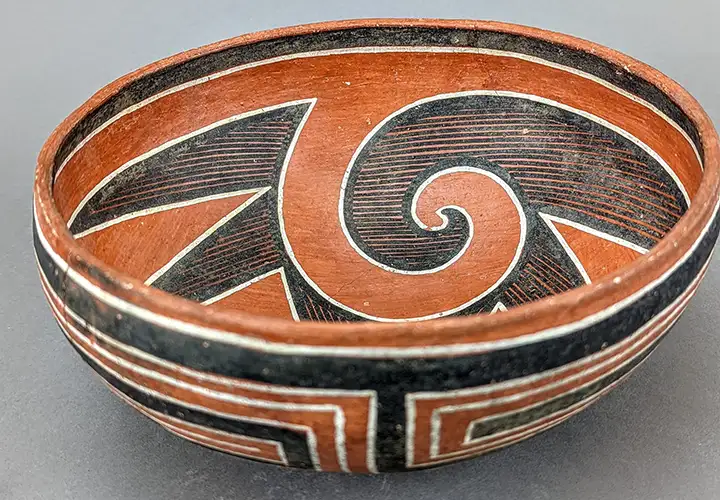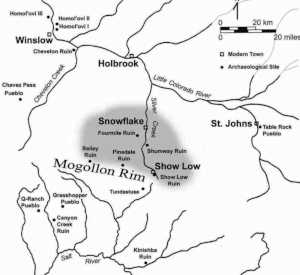Fourmile Ruin

A Fourmile Polychrome bowl
Construction at Fourmile Ruin probably began around 1275 CE. Most ruins in the Silver Creek drainage of the Little Colorado River were built about the same time. The last of the pueblos in the area was completely abandoned by 1400 CE.
I chose Fourmile because it is representative of the other pueblos built in the same area at the same time. The ancient pueblo story of eastern Arizona is hard to tell as so few sites have any sort of protection from modern looters and so many have none. In spite of the 1906 Federal Antiquities Act, both eastern Arizona and southern Utah are still hotbeds for illegal pot hunters. Some sites have been preserved by local land owners and some have been completely destroyed. The Show Low ruin was bulldozed and is now located beneath a residential subdivision on the south side of town. Most other sites show signs of bulldozers, backhoes and systematic mechanized looting to varying degrees. Fourmile Ruin is no exception.
The Silver Creek drainage was populated during the Great Drought of the last quarter of the 1200s. The people stayed until an even worse drought came in the late 1300s. The settlers were likely headed south from the Kayenta-Tusayan region and their century-long stay in the Silver Creek drainage turned out to be only a stopover along the path. In the abandonment, many found their way further south to places like the Tonto Basin, Safford Basin and Lower San Pedro Valley. Their path has been traced by following the architecture and the ceramics.
Dating of artifacts in the Silver Creek drainage is often based on clear evolutions in the pottery of the time. Generally, steps in evolution indicate a new presence in the pottery-making community or a refinement in process or decoration.
| Tularosa St. John's Black on Red and Polychrome | 1175-1275 |
| Pinedale Black on Red and Polychrome | 1275-1325 |
| Pinedale Cedar Creek Polychrome | 1275-1325 |
| Fourmile Polychrome | 1325-1375 |
During their visit to the Silver Creek area, the first Kayenta potters refined their pottery-making process as they adapted to new clays and adapted their decorations with new minerals and plant-based pigments. They learned from nearby Mogollon people who had been in the area long enough to work out the details of making pottery using local materials. And any time people from different areas come together, there is a cross-pollination of genetics, ideas, religion, politics and language. Some of that will always find expression in the art. The richness of the art also expresses the relative prosperity of a society.
The White Mountain Redware chart sort of lays out the timeline for ceramics found in excavations in the area. The "Tularosa St. Johns Black on Red and Polychrome" is a Mogollon ceramic and design vocabulary more often found to the east, around Casa Malpais. But in the Silver Creek drainage that was refined to the two Pinedale classes and then to the Fourmile class. I have seen speculation that Fourmile Polychrome evolved in time with a large influx of Kayenta people. That large influx probably overwhelmed the ability of the local environment to support them all and the people were forced to abandon the area.
Fourmile Polychrome influenced the form and designs of Salado potters over the mountains to the south in the Tonto Basin and then further south into the Lower San Pedro Valley. A major piece of that differentiation was the new practice of outlining major elements using white. Everything was still a redware based on using a heavy red slip over a buff base.
Sites of the Ancients and approximate dates of occupation:
Atsinna : 1275-1350
Awat'ovi : 1200-1701
Aztec : 1100-1275
Bandelier : 1200-1500
Betatakin : 1275-1300
Casa Malpais : 1260-1420
Chaco Canyon : 850-1145
Fourmile Ranch : 1276-1450
Giusewa : 1560-1680
Hawikuh : 1400-1680
Homol'ovi : 1100-1400
Hovenweep : 50-1350
Jeddito : 800-1700
Kawaika'a : 1375-1580
Kuaua : 325-1580
Mesa Verde : 600-1275
Montezuma Castle : 1200-1400
Payupki : 1680-1745
Poshuouingeh : 1375-1500
Pottery Mound : 1320-1550
Puyé : 1200-1580
Snaketown : 300 BCE-1050
Tonto Basin : 700-1450
Tuzigoot : 1125-1400
Wupatki/Wukoki : 500-1225
Wupatupqa : 1100-1250
Yucca House : 1100-1275
